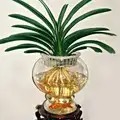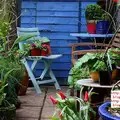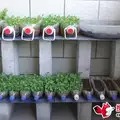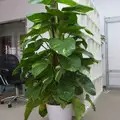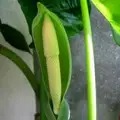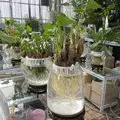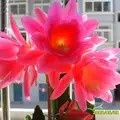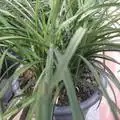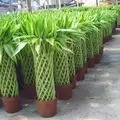Hydroponic methods of various flowers at home
Hydroponic methods of various flowers at home
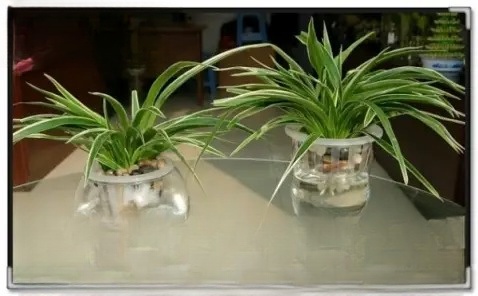
1. The green radish
is very suitable for hydroponic cultivation. It is easy to obtain ideal cultivated plants by water insertion method or root washing method. Under hydroponic conditions, new roots can sprout in about 15 to 20 days.
2. Put the aerial roots into the water together. The aerial roots can also play the role of nutrient roots and absorb water and nutrients.
3. During the growth period, dilute the special fertilizer for hydroponics and spray it on the leaves to make the leaves more colorful. 4.
The branches of the green radish are soft and elegant, and the leaves are colorful. Small plants can also be planted in wall-mounted containers, allowing them to tilt and droop, like a green curtain, fresh and elegant.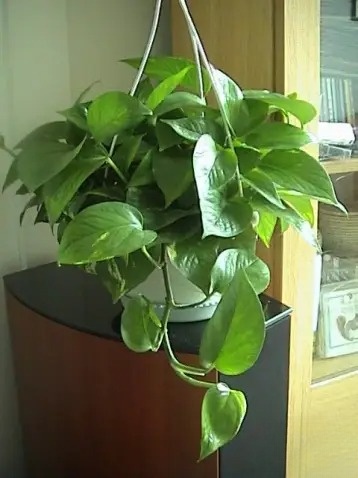
Hydroponic spider
plants It is best to choose the aerial roots of plants grown on runners [creeping stems] for hydroponic spider plants, because the aerial roots on the runners are very suitable for the hydroponic environment and the leaves are easy to manage. The root system can sprout in about 5 days of water culture.
2. When using the root washing method or division method to hydroponic spider plants, the original thick fleshy roots will rot. It is necessary to change the water every day, clean the root system, and remove the rotten roots. New roots can grow in the rhizome in about 25 to 30 days. The old roots gradually adapt to the hydroponic environment and no longer rot. At this time, nutrient solution can be used for cultivation.
3. When hydroponics are used, it is advisable to choose varieties with green leaves. Silver-thread spider plants are more difficult to operate.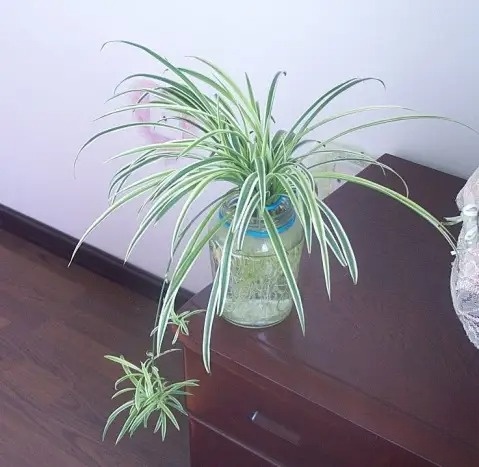
Hyacinth hydroponics
Hyacinth is a plant of the lily family and is also a bulbous flower. Hyacinth inflorescence is plump, with various colors and white roots.
Key points of hydroponics:
(1) Choose a container with a mouth that can hold the bulb. It is best to choose a gourd-shaped container with a small top and a large bottom. Transparent glass is better. Some daily utensils such as high-foot wine glasses and wine bottles can be used. You can also choose a large-mouthed container.
(2) The water temperature should not be too high. It is better to keep it below 15℃.
(3) Put the bulb on the bottleneck. After the roots grow, you can lower the water level until the roots can just touch the water surface. This will allow the roots to fully absorb oxygen and promote the growth of roots. When the roots are developed, cover the culture container with black cloth to allow the bulbs to develop further.
(4) In winter, move the container to a sunny place to promote the plant's flowers to be large and strong.
(5) You can also plant several hyacinths in the fish tank, using sand as the substrate and some shade-loving ferns as the supplement, to create a small landscape with a wild appeal that is also very unique.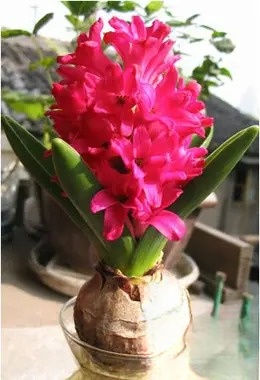
Bromeliad
After flowering, you can use the root buds for hydroponics. The root buds should not be too small when separated. You can break them off by hand, flatten the base and peel off several leaves near the base, place them in a container so that they touch the water surface, and in a shaded and 20℃ environment, they will take root in 2-3 weeks. You can also take potted plants and wash the roots and then hydroponics, but the rooting is slower, about one month and the roots are less. The pH of the nutrient solution is between pH4-5. Bromeliad is small in size and bright in color, making it a good choice for desk decoration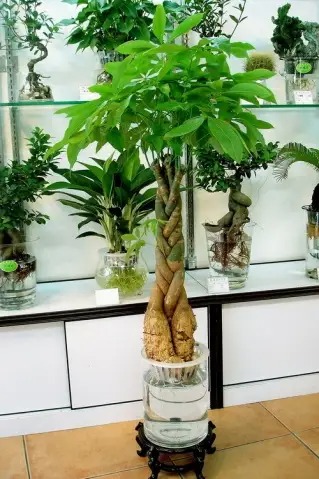
The fortune tree has a graceful posture, majestic leaf crowns, and emerald green leaves. It is elegant and lovable when placed in the family living room.
The fortune tree is a perennial evergreen shrub native to the Malay Peninsula and the South Pacific Islands. In recent years, it has been widely used in urban and rural households after cultivation and breeding. As a family cultivation, it should be based on its living habits of liking high temperature and humidity, and not resistant to frost, cold, and dryness. Pay attention to the following four points:
First, pay attention to sunlight. The fortune tree likes high temperature, humidity, and sunlight, and cannot be shaded for a long time. Therefore, it should be placed in a sunny place indoors during maintenance and management. When placing it, the leaves must face the sun. Otherwise, the entire branches and leaves will be twisted due to the leaves tending to the light. In addition, spray water on the leaves once every 3 to 5 days with a watering can. This is conducive to photosynthesis and makes the branches and leaves more beautiful.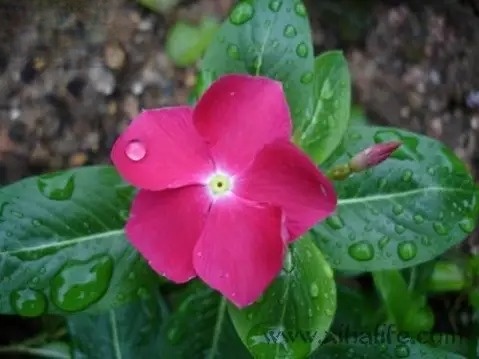
Asparagus fern
Alias: Cloud bamboo, plane grass
Family: Liliaceae, Asparagus genus
Morphological characteristics: Asparagus fern has an elegant plant shape, slender and beautiful leaf-like branches, shaped like cloud pieces, like bamboo but not bamboo, with a graceful and free-spirited posture, and white fleshy aquatic roots. With a transparent container, it is both dignified and beautiful, and noble and elegant. It is a good choice for hydroponics.Growth
habits: It likes warm, humid and semi-humid environment, with a suitable temperature of 15-25 degrees Celsius, and the minimum temperature of the engine is not less than 5 degrees Celsius. It likes scattered light, avoids strong direct light, and avoids dry air.Key
points of hydroponics:
1) Materials: Select soil-grown plants with good plant shape and vigorous growth, wash off the soil and cut off the rotten roots, and then plant them in a hydroponic container, and add water to one-third to one-half of the root system.
2) Maintenance: Change the water every 2-3 days at the beginning, remove the rotten roots in time, and after two weeks, the root system basically adapts to the environment and has grown aquatic roots. After that, change the water every 5-6 days. When the plant shows strong growth potential, use nutrient solution for cultivation. The nutrient solution should be shallow rather than deep. Replenish it every 10 days in summer. When the sediment of the nutrient industry increases, renew the nutrient solution. Generally, it is renewed every 1-2 months. Avoid direct sunlight in summer, and place the plant in a warm place with strong light.
Keep the room temperature above 5 degrees Celsius. When the air is dry, spray water on the leaves frequently to maintain high air humidity and clean branches and leaves.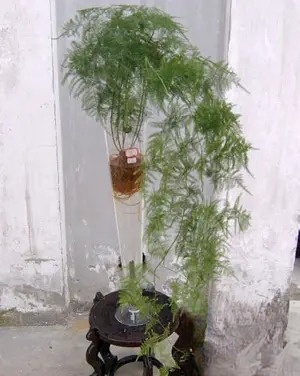
Ivy (Hedera hellx)
Alias: Foreign Ivy
Family: Araliaceae. Ivy Genus
Because of its dense branches and leaves, it is the most ideal material for vertical greening of indoor and outdoor walls, and is also an excellent ground cover plant. It is suitable for climbing buildings, walls, steep slopes, rock walls and the ground under the shade of trees. The demand for potted plants is increasing.
(I) Morphological characteristics and varieties
Evergreen climbing vines, with thin and soft branches and aerial roots. The vines grow in a spiral shape and can climb on other objects. The leaves are alternate, leathery, dark green, and have long petioles. The leaves on the nutrient branches are triangular-ovate, entire or 3-lobed, and the leaves on the flower branches are ovate to rhombus-shaped. Raceme, spherical flowers, light yellow. Drupes are spherical and black.
Commonly cultivated ivy in the same genus include Chinese ivy (H. nepalensis var. sinensis), Japanese ivy (CV. conglomerata), colorful ivy (CV. discolor), golden heart ivy (CV. goldheart), silver edge ivy (CV. siluer quetn), etc.
(II) Ecological habits
Ivy is a typical shade-bearing vine plant. It can also grow in a full-light environment. It grows well in warm and humid climate conditions and is not cold-resistant. It is not strict on soil requirements. It likes moist, loose and fertile soil and is not salt-alkali resistant.
(III) Propagation method
The nodes of ivy can naturally take root in humid air. After contacting the ground, it will naturally enter the soil. Therefore, it is mostly propagated by cuttings, using nutrient branches as cuttings. After cutting, it needs to be shaded in time, the air humidity should be high, and the bed soil should not be too wet. It will take about 20 days to take root.
(IV) Cultivation technology:
Ivy cultivation and management are simple and extensive, but it needs to be planted in moist soil and well-ventilated places. Transplantation can be carried out in early autumn or late spring, and pruning is required after planting to promote branching. In the south, it is often planted in the shade of gardens, allowing it to naturally creep on the ground or on rockery. In the north, it is mostly potted. Potted plants can be tied with various brackets and pulled to shape. In summer, they are maintained under the shade shed and watered less, otherwise stem rot is likely to occur. If this disease occurs, the diseased plants should be separated from the healthy ones, and carbendazim and methyl tobuzin should be sprayed alternately. In winter, they should be placed in a greenhouse for wintering. The indoor air humidity should be maintained and not too dry, but the pot soil should not be too wet. The hydroponic ivy can be planted as a whole plant or by cuttings. It is best to do it in spring and autumn. After the roots grow out in the cutting bed, you can put it in the planting basket for root induction. Once the ivy is well cultivated, it is very easy to maintain and clean. It is a good product for viewing at home. The cultivated ivy can be used with the general nutrient solution on the market or the nutrient solution for foliage plants. The concentration of the nutrient solution is generally 1/4 of the original formula.
(IV) Other effects
Ivy is not only a good greening plant, but the whole plant can also be used as medicine. It has the effects of dispelling wind, promoting dampness, activating blood circulation, and reducing swelling. It is mainly used to treat rheumatic joint pain, back pain, and traumatic injuries. Mash it to extract juice or add water to boil and wash the affected area. It can treat sores, swelling, measles, and eczema.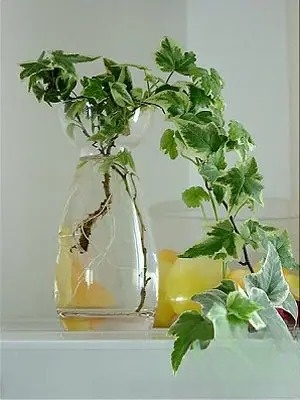
Hydroponic method of Vinca rosea
Cinnamon genus of Apocynaceae, also known as five-petal plum.
Biological characteristics: Vinca rosea is native to eastern Africa. It likes warm, slightly dry and sunny environment. The suitable temperature for growth is 18-24℃ from March to July, 13-18℃ from September to March of the following year, and the temperature in winter is not less than 10℃.
Vinca rosea is afraid of moisture and waterlogging. It is not advisable to water the pot soil too much, as excessive moisture affects growth and development. In particular, watering should be strictly controlled for indoor winter plants, and it is better to keep them dry, otherwise they are very susceptible to freezing. For open-field cultivation, pay attention to timely drainage during midsummer showers to avoid waterlogging and cause the entire piece to die.
Vinca rosea is a light-loving plant, and must have sufficient sunlight during the growth period. The leaves are green and shiny, and the flowers are bright. If it grows in the shade for a long time, the leaves will turn yellow and fall off.
It is suitable for fertile and well-drained soil, and it is tolerant to barren soil, but it should not be alkaline. The clay soil with poor air permeability and compaction results in poor plant growth, yellow leaves and no flowering . Reproduction
method: Sowing, cutting and propagation are commonly used.
Cultivation and management: When the seedlings have 3 pairs of true leaves, transplant them to 10 cm pots, 3 plants per pot. Pinch the tops of the seedlings once when they are 7-8 cm tall, and pinch them twice later to promote more germination and branching, and more flowering. Fertilize once every half month during the growing season, or use 15-15-30 "Huiyou" potted flower special fertilizer. Plant in pots or flower beds without pots, and bloom from late May to early November, for more than 5 months. Remove the remaining flowers at any time during the flowering period to prevent the remaining flowers from getting moldy and affecting the growth and ornamental value of the plants. August to October is the seed collection period for Catharanthus roseus, and they should be collected as they mature to avoid the loss of seeds.
Disease and pest control: Leaf rot, rust and root wart nematodes are common. For leaf rot, spray with 500 times diluted 65% mancozeb wettable powder. For rust, spray with 2000 times diluted 50% carboxin wettable powder. For root wart nematodes, spray with 50 times diluted 80% dibromochloropropane emulsifiable concentrate.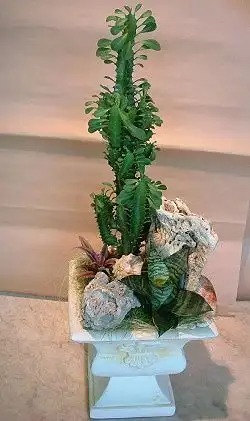
Hydroponic method of Caiyun Pavilion
Euphorbia genus, Euphorbiaceae, also known as Triangle Tyrant Whip. Native to South Africa.
Features
Caiyun Pavilion is a perennial succulent plant. The stem is upright, 3~4 ribs, dark green, with gray-green irregular beautiful spots in the center of the stem. There are serrated protrusions on the edges, and obovate leaves grow on the protrusions. There are many branches, all vertically upward, forming a unique plant shape. The whole plant contains repeated latex. Caiyun Pavilion has a peculiar shape and rich exotic style. It is a good choice for greening decoration on several tables.
Habit
Caiyun Pavilion likes semi-shade, but requires sufficient scattered light. It can withstand low temperatures of 5 degrees. Caiyun Pavilion likes dryness and avoids long-term moisture, but it is very suitable for hydroponic conditions.
Reproduction
Caiyun Pavilion is usually propagated by cuttings. From May to September, take branches about 10 cm from the mother plant as cuttings for cuttings. Cuttings should not be inserted immediately, as immediate insertion will cause the cut to rot and lead to failure. The cut of the Caiyun Pavilion will ooze out latex. When cutting, it should be dipped in plant ash or carbon powder, and air-dried in a cool place for several days. Cuttings can be inserted after the cut is fully dried, which is very easy to root.
Key points of hydroponic care
1: If scale insects occur, in addition to moving them to a ventilated and lighted place, you can use a toothbrush to brush off the scale insects, and then spray 250 liquid laundry detergent to kill them.
2: The white latex in the stem of Caiyun Pavilion is toxic. Be especially careful not to get it into your eyes.
How to obtain hydroponic materials
Cutting and root washing. The cut branches should be dried in a cool and ventilated place for several days, and then inserted into the water after the cut is dry, otherwise it will cause rot. New roots can grow after one month.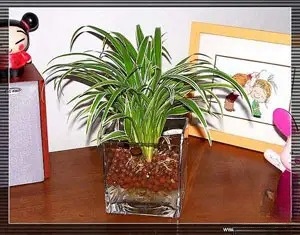
Agave hydroponics
Common varieties of Agave include: Golden Edge Agave, Golden Heart Agave, Silver Edge Agave, Green Edge Agave and Narrow Leaf Agave.
It is strong, likes sunshine, and is not shade-tolerant. It is slightly cold-resistant and can be cultivated in the open field at temperatures above 5°C. The leaves of adult Agave are only slightly frozen at a low temperature of -5°C. The aboveground part is frozen and rotted at -13°C, but the underground stems do not die. They can sprout and develop leaves the following year and grow normally. It is drought-resistant. It likes well-drained, fertile and moist sandy soil. It usually takes decades for it to bloom in its place of origin. After flowering, the mother plant dies. It does not bloom in Nanjing. Cross-pollination is required to produce fruit.
Agave can be hydroponically cultivated in a heated environment all year round. When hydroponically cultivated, all its roots need to be removed, disinfected with disinfectant, and then soaked in rooting liquid for a certain period of time. During the hydroponics period, attention should be paid to the cabbage worms eating its leaves and heart, thus losing its commercial value and ornamental value. If insects are found, they can be caught manually or killed with insecticides.
The hydroponically cultivated roots should be taken to a sunny place from time to time, and not placed in a dark place for a long time, otherwise the leaves will easily turn white and become thin, thus losing their ornamental value. In winter, attention should be paid to heat preservation. During the day, it should be placed in a sunny place near the window. At night, the glass bottle needs to be placed in a plastic or cardboard box in a room without heating. If the leaves turn yellow or droop down and are listless, it may be frostbite. At this time, some insulation measures need to be taken. Then put it away from the door and window, and remember not to put it in a place close to the north. When changing water in winter, you can use warm water of 12 to 18 degrees. Agave has strong resistance and can safely survive the winter as long as you pay attention to management.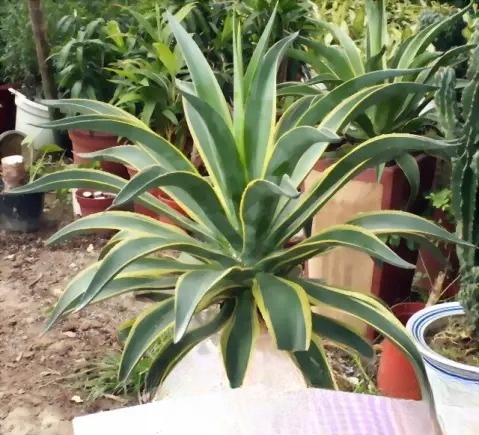
The daily management of the hydroponic flowers of "Hydroponic Flower King" is very simple. Except for changing the nutrient solution every 7-10 days in the spring and summer when the plants are growing vigorously, and changing the nutrient solution every 15-20 days in autumn and winter, it does not require special care. Usually, you only need to spray water on the leaves in the dry season or in the air-conditioned environment; when there is dust on the leaves, wipe them with a clean cloth or paper towel dipped in water. It saves the trouble of fertilizing, changing soil, and watering every day, which is very suitable for the fast-paced lifestyle of people in modern society.
2. Clean and fashionable
Because hydroponic flowers are completely separated from the cultivation environment of soil and grow directly in a relatively sterile or less sterile nutrient solution environment, they will not pollute our living environment due to pests and germs parasitic in the soil like soil-cultivated flowers, making our homes safer, cleaner, and more assured. Moreover, because it is separated from the soil, we can use more beautiful vases, utensils, and materials to plant. We can not only appreciate the flowers and leaves, but also appreciate the process of root growth that is not often seen and their various beauty, which is very neat and fashionable.
3. It is applicable to many varieties, and the technology is easy to master and operate.
Because the adaptation technology of plant roots from soil environment to aquatic environment has been conquered, "Hydroponic Flower King" does not need to cultivate aquatic roots through planting baskets, nor does it require early computer and electric field mutagenesis. It only needs very simple technical treatment, and the soil root system can be quickly transformed into an aquatic root system. Anyone can grow vigorous and lush hydroponic flowers, which greatly shortens the production cycle, saves production costs, and makes the product have a larger profit margin, increasing the competitiveness of the product in the market; at the same time, because of the low production cost, it also allows more people to enjoy the lifestyle brought by new technology to people, and rapidly expand the market share. Because no planting baskets are used, hydroponic flowers become more beautiful and refined.
Because rainwater will change the concentration and pH value of the nutrient solution, hydroponic flowers are not suitable for outdoor planting. Some light-loving plants are difficult to be hydroponically cultivated indoors at home, but the common shade-loving and semi-shade-loving flowers can basically be successfully hydroponically cultivated. The number of experimental varieties has reached nearly 400. If your home has a sunlight or artificially regulated greenhouse, then in theory any plant can be hydroponically cultivated, but the difficulty is different. 4. Green and environmentally friendly
, can be co-cultured with flowers and fish
"Hydroponic Kao" nutrient solution does not contain toxic ingredients, so it can be co-cultured with fish and flowers for a long time without any side effects that are not conducive to flowers or fish. The fish in our store still grow well after long-term breeding, and some customers add nutrient solution to the aquarium to fertilize water plants, and the effect is also very good. Practice has proved that it is safe and reliable. At the same time, because of the special ingredients, the nutrient solution is not easy to breed mosquitoes, and when you change the water, if you pour the discarded nutrient solution into the soil of your home to plant potted flowers, you will have more unexpected surprises. Facts have proved that the "hydroponic flower king" nutrient solution is a truly green and environmentally friendly nutrient solution, and the effect is very obvious.
Use waste containers, such as beverage cans, large-mouth bottles, white polystyrene hard foam boxes (boxes), etc., and with a little arrangement, they can become hydroponic carriers of varying sizes and shapes. They can not only adapt to local conditions and make the best use of them, but also green the surrounding environment, which is quite interesting to return to nature.
1. Bottles and cans
1. Such as metal beverage cans, glass or plastic large-mouth bottles, paper foil-coated square beverage boxes, etc., originally contain liquids. As long as the original contents are rinsed and refreshed, they can be used as hydroponic carriers for standby.
2. Planting cup: According to the size of the mouth of the selected container, choose a plastic cold drink cup that is just about 1/3 of the mouth as a carrier for anchoring plants. As shown in Figure 1, a "well"-shaped hole is cut out at the bottom of the cup so that the roots can extend into the nutrient solution through the bottom of the cup, and the anchor of the plant will not leak out. The hole also has a ventilation function.
3. Anchoring of the plant: Prepare a piece of non-woven fabric (non-woven fabric) of about 8×12 cm for clothing padding, and gently rinse off the soil of the plant seedlings to be hydroponically cultivated or the potted flowers with soil purchased, etc., without damaging the root system. Wrap the roots with non-woven fabric and roll them up, and then wrap them with porous plastic sponge (used as shoulder pads for tops or scraps cut from sofas and seat cushions, etc.), or a small amount of rock wool, glass wool (used as insulation materials, there are yellow ones, and there are also yellow ones with white), etc., so that they can be stuffed into the plastic planting cup to anchor the plant. If you don't have the above things on hand, use flower arrangement mud, which can be used as anchoring material after appropriate cutting. Immerse the non-woven fabric roll wrapped with the root system together with the exposed root system into the bottle containing the nutrient solution. It must be noted that the space distance between the nutrient solution surface and the bottom of the planting cup should be no less than 1 cm. This is the key to the success of hydroponics. With the help of the infiltration and absorption of the non-woven fabric, the nutrient solution can continuously supply nutrients to the root system. After about half a month, the nutrient solution gradually decreases as the crops grow and evaporate. When the liquid level drops to 1/4 of the height of the container, new nutrient solution can be added. At this time, the distance between the liquid surface and the bottom of the planting cup can be larger, about 3 cm.
4. Cultivation management: If a transparent glass container is used, the bottle body must be covered with a sunshade to prevent direct sunlight from breeding algae and competing with the cultivated material for nutrients. In summer, in order to prevent the liquid temperature from rising sharply due to sunlight exposure, it is best to have sunshade measures or place it in a place where the sun cannot directly shine.
2. Boxes
1. Box: Usually used as a polystyrene white rigid foam box for shockproof packaging, or corrugated cardboard boxes with a certain strength, wooden boxes, etc. can be used. Generally, it is about 35×25×15 cm 60×40×16 cm. If there is a hole in the bottom (body) of the box, it can be leveled with a wooden board or foam board. The box is lined with black agricultural film to prevent nutrient solution leakage. If it is confirmed that the box will not leak and is not light-transmitting, the film can be omitted. If there is no black film, other films can also be used as a substitute.
2. Upper cover: The upper cover also functions as a planting board. Find a polystyrene foam board with the same area as the box and a thickness of about 2.5 cm as the upper cover and planting board. Open a certain number of planting holes with a diameter of about 6 cm on the board. Like bottles and cans, as long as the selected plastic cold drink cup can be placed in it, and about 1/2 of the cup height is exposed. The number of planting holes depends on the size of the box. Generally, there are 6 to 16 holes. In addition, a small hole with a diameter of 2 cm is opened on the side of the upper cover, near the inner side of the box, for the purpose of monitoring the liquid level of the nutrient solution and adding nutrient solution.
3. Planting cup: The material selection and preparation are the same as those of bottles and cans.
4. Floating board: Take a polystyrene foam board that is 2.5-3 cm smaller than the net area of the box on all sides and 2.5-3 cm thick as the floating board. Small holes with a diameter of 1-2 cm are opened regularly on it to increase the air content of the floating board and facilitate the roots to extend into the nutrient solution. A thin layer of rock wool (dry thickness of about 1 cm), or glass wool of the same thickness, or non-woven fabric of 25-50 g/m2 is laid on the floating board to absorb the nutrient solution. If these things are really unavailable, medical sterilized degreased gauze can also be used as a substitute. The area of the infiltration cotton layer is about 6 cm larger than that of the floating board, so that the excess part laid on the floating board can hang freely from the floating board (like an apron), immerse in the nutrient solution and absorb the nutrient solution, thereby ensuring that a moist layer with nutrient solution is formed on the floating board. The roots of the plants can stretch freely on the floating board and have more direct contact with the air. The other part of the roots can still absorb nutrients through the four sides of the floating board or through the small holes on the floating board. This method can make up for the unfavorable environment of general static hydroponics that cannot circulate nutrient solution and oxygenate.
5. Cultivation management:
(1) Pour the prepared nutrient solution into the cultivation box. When the plants are just planted, the liquid level should be slightly higher, and the floating board should be controlled to just touch the non-woven root roll extending from the planting cup so that the nutrient solution can be absorbed. A certain amount of space must be left in the cultivation box for the highest liquid level. When the nutrient solution is reduced to 3-5 cm due to plant absorption and transpiration, nutrient solution should be added until the liquid depth is about 10 cm.
(2) When the nutrients in the nutrient solution change significantly, or when there is precipitation, turbidity, stench, or infection with pathogens, the nutrient solution should be updated as appropriate until it is completely updated.
Hydroponic method of azalea
The characteristic of soilless cultivation is that the soil is replaced by an artificial substrate. Hunan Forestry Institute uses solid substrate for soilless cultivation of azalea and obtains very satisfactory results. The variety is summer azalea. The crown structure of soilless cultivation is compact, the amount of flowers is large, the flower diameter is large, and there are few diseases and insect pests. It not only improves the quality of flowers, but also greatly reduces the heavy physical labor. It is a cultivation method worthy of promotion.
1. Preparation of substrate
The root system of azalea is very delicate, and the substrate is required to be loose to facilitate ventilation and drainage. Use 1 part of vermiculite, 1 part of pearl sand, 1 part of river sand, and 1 part of coal slag in proportion. After mixing, sterilize the substrate with 0.1% carbendazim solution, mix it evenly into the substrate, and cover it with plastic film for 1 day. Then rinse with clean water several times, dry it, mix it with 0.4% agricultural compound fertilizer liquid, cover it with plastic film for one month, and then put it in the pot for use.
2. Preparation of nutrient solution
Azalea has strict requirements on fertilizer. During the growth period, thin fertilizer should be applied frequently. According to experiments, agricultural compound fertilizer is mainly used, supplemented with trace elements, the pH value is controlled at about 5, and low-concentration foliar fertilizer is sprayed to achieve good results.
Preparation of macroelements: 1 liter of water plus 2 grams of agricultural compound fertilizer and 0.5 grams of magnesium sulfate are used as standard solution.
Preparation of trace elements: 1 liter of water plus 20 grams of disodium ethylenediaminetetraacetic acid, 15 grams of ferrous sulfate, 4 grams of manganese sulfate, 6 grams of boric acid, 0.2 grams of zinc sulfate, 0.1 grams of copper sulfate, and 0.2 grams of ammonium molybdate are used as mother liquor. When using, add 1 ml of trace element mother liquor to 1 liter of standard solution, which is the full amount of elements. Preparation of foliar fertilizer: add 1 gram of urea, 1 gram of potassium dihydrogen phosphate, 0.02 grams of boric acid, and 0.1 grams of V.B1 to 1 liter of water.
3. Water and fertilizer management
Because the substrate has good drainage and air permeability, but poor water retention, the amount of watering is generally more than soil culture, just to keep the substrate moist; at this time, it is the time for buds and leaf buds to germinate, and the amount of fertilizer required is relatively large. Water the full amount of nutrient solution about once every 10 days. From March until the buds burst, spray foliar fertilizer about once every 15 days. After flowering, the water requirement is large. In addition to watering every day, the leaves should be sprayed in the evening. At this time, the amount of fertilizer required is also large. It can be changed to watering the nutrient solution once a week and spraying the foliar fertilizer once to promote the growth of new branches and facilitate the differentiation of flower buds. After entering the dog days, pay attention to keeping the substrate moist and spray water on the leaves. The amount of fertilizer can be reduced to watering the nutrient solution about once every 20 days. After the autumn cools down, the amount of fertilizer can be gradually increased. The full amount of nutrient solution can be applied once every half a month, and foliar fertilizer can be sprayed 1-2 times to promote the healthy growth of flower buds. After winter, the physiological activity of azalea is weak, so it is not suitable to apply fertilizer. It can be watered appropriately depending on the dryness and wetness of the substrate. During the cultivation process, there was basically no disease or insect pest.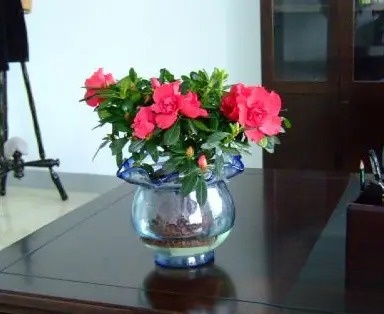
The hydroponic method of lucky grass.
Lucky grass, also known as Guanyin grass, is a perennial green herbaceous plant of the genus Lucky Grass in the Liliaceae family. The leaves are clustered, broad and linear, with concave midribs and gradually pointed tails, 15 to 40 cm long; the stems are creeping roots, with roots at the node ends; the flowering period is from September to October, the flowers are lavender, upright, with terminal spikes, about 6 cm long; the fruit is bright red and spherical; it is native to the southwest region, likes warm and humid environments, is relatively cold-resistant and shade-tolerant, has low requirements for soil, and has strong adaptability. Because the lucky grass has a beautiful plant shape and verdant leaves, if we take advantage of its cold-resistant and shade-tolerant growth habits, put it into various goldfish tanks or other glass containers for hydroponic cultivation, and then put it on the bar counter or coffee table, there will be water in the tank, stones in the water, roots in the stones, and clear and clean mutual visibility, which is a delicate and elegant work of art. The following is an introduction to its cultivation method.
1. Material selection. Select plants with dark green leaves, vigorous growth, and no pests and diseases, carefully dig them out of the soil with a shovel, and clean their roots. In the process of digging, pay attention to digging as deep as possible and taking as much soil as possible. There are two purposes for doing this. One is to avoid damaging the roots, which is conducive to the growth of hydroponic cultivation; the other is that because the water is transparent, the complete roots can show a unique beauty in the water.
2. Pressing stones. Select pebbles or rain flower stones used to pave garden paths, wash them clean, first lay a layer on the bottom of the glass tank, place the lucky grass vertically on the stone, and then use stones to press its roots firmly to prevent it from falling over, and pour clean water into the glass dish until the entire root is completely immersed. The transparency of water determines that the pressing stone should also have certain aesthetic skills. The author can design it through his own creativity to highlight the personality.
3. Management. Since the roots of the lucky grass are soaked in water for a long time, the water is prone to produce odor over time, so the water should be changed frequently, preferably once a week. As for fertilization, a few drops of nutrient solution or potassium dihydrogen phosphate solution can be applied regularly. Lucky grass is relatively shade-tolerant, and 1 to 2 hours of fluorescent light every night can meet its photosynthesis needs.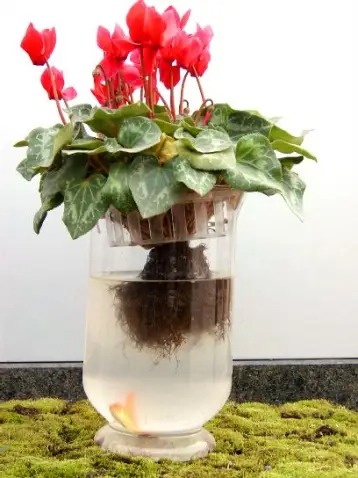
How to grow cyclamen hydroponically:
Choose cyclamen and containers. Choose cyclamen plants that are 1 to 3 years old, free of pests and diseases, growing vigorously, and about to bloom. It is best to use soilless culture media such as perlite, vermiculite, sawdust, etc., which will not damage the roots or slow down the seedlings after changing the environment, and will adapt quickly. Water culture containers are simple and economical, and can be used to recycle waste in life. Any container that can hold water, such as fish tanks, tea cups, beverage boxes, wine bottles, and vases, will do; transparent containers are best, and the roots, stems, leaves, flowers, and fruits can all be fully appreciated. No matter what container is used, its size, height, color, etc. must be coordinated with the cyclamen plant, so that the water-grown cyclamen can show its exquisite, crystal-clear and elegant charm.
Cyclamen flowering period is generally from October to June of the following year, so the water culture period is generally from September to April of the following year. Remove the selected cyclamen plants from the pots and wash the substrate to which the roots adhere with 20℃ warm water, taking care not to damage the roots. Then place them directly in a pre-prepared container, with the water depth flush with the root zone, and the maximum depth should not exceed 1/3 of the bulb to prevent the bulb from rotting. Finally, place them in a suitable position indoors, add water and nutrient solution regularly. After two to three months of water culture, the flowers will wither, and the plants will be taken out and planted in the cultivation substrate to spend the summer.
Water quality and water temperature The water used for water culture of cyclamen is preferably mountain spring water or magnetized water, which is clean, not turbid, and does not precipitate, and contains a variety of trace elements necessary for plants. No water change is required during the entire water culture period. Tap water contains chlorine, which is not conducive to the growth of flowers, and is prone to turbidity and precipitation. The water needs to be changed every few days and should be avoided as much as possible. The water temperature should be close to the indoor temperature at the time, generally 10℃ to 20℃.
; Light and indoor temperature Cyclamen likes a sunny environment. The water-growing container should be placed on a sunny table or windowsill indoors, not directly on the radiator. The most suitable indoor temperature is 15℃ to 20℃, the highest should not exceed 25℃, and the lowest should not be lower than 10℃. Add nutrient solution Cyclamen should also be regularly supplemented with nutrients during the flowering period. Generally, 50 ml of 1:100 nutrient solution for flowering plants is added to each plant every 10 days. Mountain spring water should also be used to prepare the nutrient solution. If you find yellow leaves, small leaves, small flowers, etc., you can add more nutrient solution as appropriate, excluding root rot.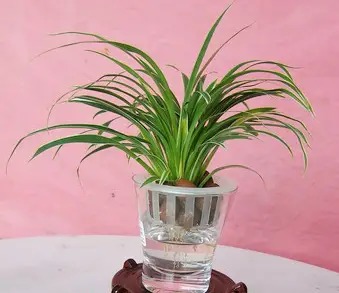
Hydroponic silver-edge grass
Chinese name: Libang grass
Other name: Silver-edge grass
Family name: Poaceae
Latin name: Arrhenatherum elatius
Characters: Perennial herb Plant
height: 50-100 cm high
Flowering period: Summer (June-August)
Cold resistance: Cold-resistant (above -5℃)
Shade tolerance: Positive
Morphological characteristics: underground stems are white and bead-shaped; aboveground stems are clustered and smooth. Leaves are clustered, linear-lanceolate, 30cm long, about 1cm wide, with yellow-white edges. Panicles have long stalks, about 50cm, with branches; spikelets have two flowers, the upper flowers are bisexual or female, and the lower ones are male flowers; flowering period is June-July. Native to Europe.
Habits: Extremely strong, cold-resistant and drought-resistant, not selective soil. In midsummer, the aboveground parts often wither and dormant, and sprout again in early September.
Reproduction and cultivation: Usually, division is carried out every 2-3 years, in spring from March to April or in September when new leaves are first sprouted after dormancy. The old plants are dug up and separated. Each plant should have 2-3 new buds and bead-shaped underground stems. Old plants should be pruned every year to prevent the leaves from growing too long. When the underground stems are exposed, soil should be added in time to make the plants vigorous and beautiful. If too much fertilizer is applied or there is a lack of fertilizer during cultivation, the white spots on the leaves will disappear and the leaves will turn green, affecting the ornamental effect.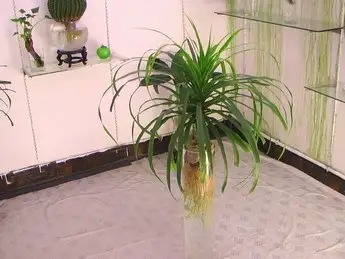
Hydroponics of Dracaena: The plants of Dracaena for hydroponics can be obtained by referring to the above propagation methods, or they can be obtained directly from soil culture. The specific methods are as follows:
Observe the roots and hydroponics, sterilize and kill insects one week before cultivation, and select plants with good appearance for cultivation. If hydroponics is carried out according to the above cuttings (remove the roots of soil culture materials for rapid propagation and rooting), it is best to put the planting basket in it first, and put it into the mutagenesis pool for mutagenesis when the roots grow 5-6 cm long and do not return to land. At the beginning, the concentration of nutrient solution should be lower. After the plants adapt to the growth environment in water, the concentration can be increased according to the plants, and oxygenation is also reduced, and finally oxygenation is stopped. When the roots grow long enough to be bottled, you can bottle them!
Clay planting: Rooting before potting is the same as hydroponics. Don't plant the plants too low when potting, otherwise it will be bad for the future growth of the plants. When the roots of the plants grow out of the inner pot, they can be sold.
During the production period, spray fungicides and foliar fertilizers every other week. For home maintenance, in addition to referring to the product manual, you should also follow its growth habits. Stop fertilizing during the dormant season and place it in a sunny place. For expanded clay planting, less water is needed in winter and early spring. If it is placed in a dark place for too long, the leaves will turn yellow and lifeless. Moreover, the tips of the leaves at the base will easily turn black, as if they have been scalded by boiling water. Do not lack water during the growing season.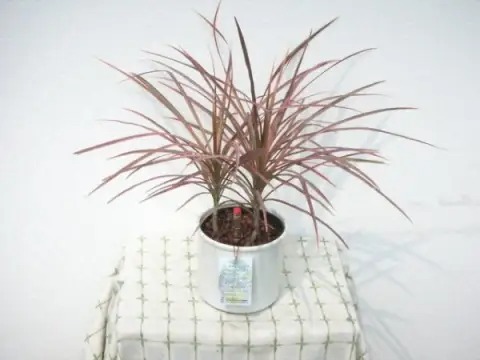
Tricolor Dracaena Alias: Tricolor Dracaena, Rainbow Dracaena, Colored Cordyceps
Family: Agavaceae, Dracaena
Morphological characteristics: small evergreen tree. Thin stem, upright, up to 3 meters high. The leaves are 15-60 cm long, 1-2 cm wide, sword-shaped. There are milky white, yellow-white, and red stripes on the green leaves. It is a unique variety in the genus Agave.
Distribution and habits: Native to Madagascar.
Likes warm, humid, bright scattered light environment. More shade-tolerant, avoid strong direct sunlight. Suitable growth temperature is 18-28 degrees. The wintering temperature needs to be above 10 degrees.
Reproduction method: cuttings
Hydroponic points:
1) Hydroponic cultivation is easy to root using water cutting method, and the water-grown roots are white and have great ornamental value. Changing water is the key to success, especially when it is just planted. Changing water every other day can increase its nutrient content until the root system grows out. After adapting to water cultivation, you can change or add water once a week or month according to the season.
2) When the water temperature is above 35 degrees in summer, the root system is prone to rot. At this time, you should stop using nutrient solution and only use clean water to cultivate it. In addition, you should increase the number of water changes to keep the water clear.
3) Place it in a brightly lit position indoors. Generally speaking, change the water once a month in autumn and winter. If you use a transparent container for water cultivation, wipe off the material attached to the container with a soft cloth while changing the water to make it transparent, so that the beauty of the plant's root system can be better displayed. After changing the water, you can drop a few drops of nutrient solution sold on the market into the water or add some potassium dihydrogen phosphate diluted with 1000 parts of water to provide the nutrients needed for plant growth. If you spray foliar fertilizer or 1000 parts of potassium dihydrogen phosphate as foliar topdressing during the growing season, it can make it grow stronger.
Can remove: toluene, xylene, benzene, trichloroethylene, formaldehyde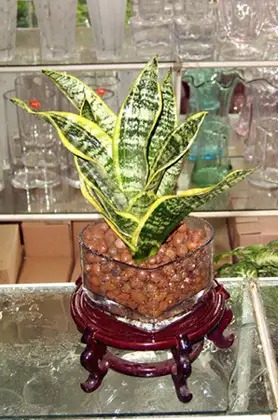
Tiger tail orchid is a perennial herb with creeping rhizomes. The leaves grow in clusters, often in bundles of 2 to 6. The leaves are upright, leathery, thick, with a short tip at the tip, dark green, with light gray-green horizontal stripes, and are named because the stripes are like tiger skin. It is more than 80 cm high and 3 to 7 cm wide. It blooms in spring and summer, with spike-shaped inflorescences, 3 to 8 small flowers in a bunch, and the flowers are white or light green and fragrant.
Tiger tail orchid likes warm climates, and the suitable temperature for growth is 20 to 30 degrees. It is not cold-resistant and stops growing when it is below 13 degrees. The wintering temperature is not lower than 8 degrees. When the temperature is too low, it often rots from the base, causing the death of the entire plant.
Tiger tail orchid likes light, but it should be protected from the sun in summer. It is very shade-tolerant and can be displayed in the shade for a long time.
Tiger tail orchid is a desert plant that can tolerate harsh environmental conditions.
Reproduction is usually carried out by division. Division is usually carried out in spring and autumn in combination with pot removal. Remove the plant from the pot and separate the daughter plant from the mother plant with a sharp knife. Try to avoid damaging the root system and let the separated daughter plant carry as many roots as possible. After the daughter plant is separated, it should be placed in a dark place indoors to prevent rain and control watering to avoid rotting of the incision. Normal maintenance can be carried out after the new leaves grow out.
Cuttings can be used for large-scale propagation of Sansevieria. Cuttings are carried out between May and July. Select strong and full leaves and cut them into small segments of 5 to 7 cm. Whole leaves can also be used for cuttings. The cut leaves should be placed in a dry and cool place for several days. After the incision is dry, insert them straight or obliquely into the medium. The insertion depth is 1/3 or 1/2 of the length of the cut segment. Water it thoroughly after insertion. When cutting, remember the upper and lower positions of the cuttings. If you insert them upside down, they will not take root. Under the conditions of 15 to 20 degrees, roots will grow from the base or rhizomes will grow in about a month and gradually grow into new plants. When the seedlings grow 2-3 leaves, they can be potted and planted.
Don't fill the pot too full with water, soaking the roots. Leave a small part of the roots exposed to the water surface to absorb oxygen. After the hydroponic roots grow, you can add a little nutrient solution~~~~Change the water every three or four days in summer and six or seven days in winter~~~It depends on the turbidity of the water~~~~~~~Generally, woody flowers are more difficult to hydroponically grow, so you have to be patient.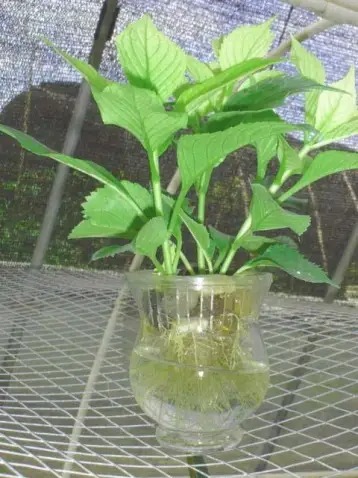
Scientific name: Hydrangea macrophylla
Alias: hydrangea, fighting ball, shade hydrangea, grass hydrangea, hydrangea
Family: Saxifragaceae Hydrangea
Plant characteristics Hydrangea is native to the Yangtze River Basin and the provinces to the south. The natural plant height is 1 to 2 meters, and the potted height is mostly controlled at 30 to 50 cm. The leaves are opposite, obovate or elliptical, with serrated edges. The umbel is terminal, 20 cm in diameter, nearly spherical, with few and small sexual flowers, and many and large asexual flowers. The flower color is changeable, white at first, gradually turning blue or pink, the natural flowering period is from May to July, it is a deciduous shrub with green leaves and bright flowers. It has a long viewing period and is deeply loved by people.
Ecological habits Hydrangea likes a warm and humid environment, and the suitable growth temperature is 18℃ to 28℃, not lower than 5℃ in winter. The light should be semi-shaded, and too strong will cause the leaves to burn and curl. It likes loose and fertile soil, has a large water demand, but avoids waterlogging. It is highly resistant to harmful gases such as sulfur dioxide.
Common cultivated varieties Big Hydrangea (V. hortensica): All flowers are sterile, and the sepals are ovate. Blue-edged Hydrangea (V. coerulea Wils): The flowers are bisexual, dark blue, and the flowers on the edges are blue or white. Hydrangea (V. otaksa Bailey): The flowers are sterile, the inflorescence is large, up to 20 cm in diameter, the leaves are thick, the inflorescence is spherical, blue or light red, and it is mostly used in gardens. Silver Hydrangea (V. maculata Wils): There are two types: fertile and sterile. The leaves are narrow and white on the edges. They are used for ornamental leaves.
Reproduction method Hydrangea can be propagated by division, layering, cuttings, etc.
Cuttings can be carried out in the greenhouse all year round. It is usually carried out from May to June, combined with early spring pruning and post-flowering shaping. Select semi-lignified branches without diseases and insect pests, each section is 10 to 15 cm long, retain 2 to 3 nodes and 1 to 2 leaves on the top, and insert them in a seedbed with river sand or vermiculite as the substrate, and shade them appropriately. Keep the substrate moist and the air humidity above 80%. Rooting will begin in about 18 days. Gradually reduce the number of water sprays and increase the light. Transplanting can be done in about 1 month.
Cultivation and management: Planting the cuttings should be potted in time after rooting. Hydrangea likes loose, fertile, and well-drained soil. It is usually prepared with leaf mold, garden soil, and organic fertilizer in a ratio of 4:4:2. For large-scale production, it is suitable to use grass carbon, perlite, and organic fertilizer in a ratio of 6:2:2. Thoroughly disinfect before use. Fertilization:
Hydrangea likes fertilizer, and organic fertilizer is usually applied every half a month. In the early growth period, more nitrogen fertilizer is needed, and in the flower bud differentiation and bud formation period, more phosphorus
and potassium fertilizer is needed. You can also spray 0.1% to 0.2% potassium dihydrogen phosphate on the leaves 2 to 3 times, and stop fertilizing after the flower buds are translucent. Watering The evaporation of hydrangea leaves is very large, so it is necessary to water them in time. Even a short period of water shortage and wilting can cause the leaf edges to dry up and the flowers to die. Especially in summer, it is necessary to shade and cool down to reduce evaporation, and maintain air humidity above 60%. In addition, the color of hydrangea flowers is affected by the pH value of the soil. It usually appears blue in an acidic environment and red in an alkaline environment. Therefore, the pH value of water should be determined according to the color of the flowers required.
Temperature Hydrangea is not resistant to high temperatures. The temperature is required to be between 15℃ and 25℃. High temperatures will make the plants short and the color fade, reducing the quality. After the flower buds are colored, the temperature should be kept at 10℃ to 12℃ to improve the color and keep the flowers fresh.
Light Hydrangea is shade-tolerant. Direct sunlight can cause sunburn, so it needs to be shaded. Usually, 60% of the light should be shaded during the growing period, and appropriate light should be shaded after the inflorescence is transparent to prevent the color from fading and losing its luster.
Pruning Hydrangea has a strong germination ability, and many nutrient branches will sprout at the base of the plant. In order to reduce nutrient loss, they should be removed in time. If old branches need to be replaced, strong nutrient branches can be selected as reserve branches. Shorten them in time after flowering, and keep 2 to 3 strong buds to promote new branches.
Flowering period regulation To make hydrangea bloom during the Spring Festival, you can choose 3 to 5-year-old strong plants. After 14 days of low temperature treatment at 2 ℃ to 4 ℃, move them into the greenhouse for heating, maintain 10 ℃ to 20 ℃, and they will bloom in 50 to 60 days. Pay attention to frequent ventilation, maintain good light conditions and high air humidity, and apply organic liquid fertilizer every half a month until flowering.
Pest and disease control Hydrangea has few pests, mostly aphids, spider mites, etc., and can be sprayed with systemic agents for prevention and control while ensuring good ventilation. Common diseases are mostly leaf diseases, such as white rot, gray mold, leaf spot, etc. Therefore, it is necessary to spray pesticides regularly for prevention. After the disease is discovered, the pesticides must be sprayed in time. Severely diseased leaves can be removed and burned.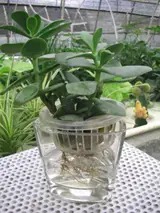
Jade Tree
[Other Names] Crassula, Crassulaceae, Jade Tree, Ground Root.
[Scientific Name] Crassula arborescens
[Family] Crassulaceae, Crassulaceae.
[Morphology] Evergreen succulent plant, plant height 45-75 cm, stem semi-lignified. Single leaves opposite, thick and fleshy, broadly elliptical, entire, 3-5 cm long, 1-3 cm wide, dark green, glossy, leaf margins turn red after exposure to light, horticultural varieties include variegated and colorful leaves.
[Habits] Native to South Africa. Likes warmth, drought resistance, light, and semi-shade, and grows best under bright scattered light conditions. Likes fertile, loose, well-drained and breathable sandy loam.
[Propagation] Cutting propagation. Both branch cuttings and leaf cuttings are easy to root, and can also survive by water cutting. The cutting time is between May and September. Take 5-10 cm branches or 1 leaf and insert them into plain sandy soil. Pay attention to moisture retention. Roots will grow after a week.
[Cultivation] Use 2 parts of garden soil and 1 part of leaf humus for potting soil, add appropriate amount of river sand to make culture soil. Water the seedlings after potting and place them in a shaded place. After survival, place them in a bright place without direct sunlight. Pay attention to shade and ventilation in summer. In order to make the plant plump and compact, the fertilizer and water should not be too much at ordinary times, and the potting soil should be alternately dry and wet. Bring it indoors to keep warm in late autumn, and the room temperature should be above 7℃. Do not water too much in winter. The pot should be repotted and the soil should be changed once every spring.
Although the jade tree is easy to propagate, plant and manage, it is still common to see some residents' jade trees on the balcony in spring, summer and autumn, but they will become wilted and pale after winter, and even become "bare-chested chickens". This is mainly because flower growers only see the easy cultivation side of jade tree, but ignore its fragile side. After the severe cold, they still place it on the open balcony, allowing it to be attacked by cold wind and freezing, causing the jade tree to be frozen. After being frozen, the fleshy leaves and tender stems of jade tree begin to show injuries as if they were scalded by boiling water, and then gradually become soft, shrunken, and finally fall off. In severe cases, only the bare main stem is left.
Therefore, it is very important to do a good job of wintering jade tree in balcony pots. The following aspects should be focused on:
1. Move the pot indoors in time. After entering winter, move the jade tree to a room that can maintain a temperature of 7℃ to 10℃ for insulation. On warmer days, the jade tree can be moved to the balcony at noon to let it bathe in the sun, and still moved indoors at night.
2. Control the dryness and humidity of the pot soil. In winter, the pot soil is mainly slightly dry, and spray fine mist on the leaves to replenish water in time. Under normal circumstances, there is no need to water the pot soil directly.
3. Move it into a greenhouse for insulation. If conditions permit, the pots can be moved into the greenhouse. If conditions do not permit, plastic film can be used to cover them. However, attention should be paid to the humidity inside the cover. If the water and humidity are too high, the cover should be opened in time for
ventilation to prevent leaf rot. 4. If the jade tree has suffered frost damage due to mistakes in the early anti-freeze measures, do not discard the plant easily. As long as the frozen leaves and twigs are removed and the plump main stem is preserved, and fertilizer is applied appropriately in the spring, new branches and leaves can still sprout on the main stem. Generally, after 1 to 2 years of cultivation, it can develop into a perfect jade tree.
Hydroponics of jade tree:
You can choose to cut branches from the mother plant of jade tree for cuttings in spring, summer and autumn, and sterilize, disinfect and kill insects one week before cutting. After the branches are cut, keep the substrate at a certain humidity. At the beginning, you need to spray water and shade. After the callus tissue grows below, you should spray less water, or not spray water, otherwise it is easy to drop leaves and rot. After the roots grow 2 to 3 cm, you can put them on the hydroponic seedling bed for hydroponic root pulling.
[Use] Indoor decoration, suitable for embellishing the hall. Attachment: The same foliage plant Crassula portulacea, also known as Crassula portulacea, has obovate leaves and the cultivation method is the same as that of Jade Tree.
It can be hydroponically cultivated without nutrient solution~~~ For example, Chlorophytum can grow well without nutrient solution~~~~ You can put two compound fertilizers in it~~~~~ Or soak the nutrient soil in water, take the clear part on top, and use it as nutrient solution~~~~~ Nutrient solution can be bought in flower shops~~~~~~~~~~~~ Hydroponics
of watermelon rind must be done in spring and autumn, hydroponics in winter will definitely die, it is best to insert the leaves of watermelon rind into the soil, and choose those with roots for hydroponics. At the beginning, change the water frequently and wait until the roots grow, then you can add nutrient solution~~~~~~~~~~~~~~
My miniature coconut palm has grown very well, thank you! I am a lazy person, and there is another way to reduce the number of water changes. Just add 3 drops of Amway's Lexin to the water. It works very well, but the amount varies for each bottle of water. You can start with a small amount and slowly explore
.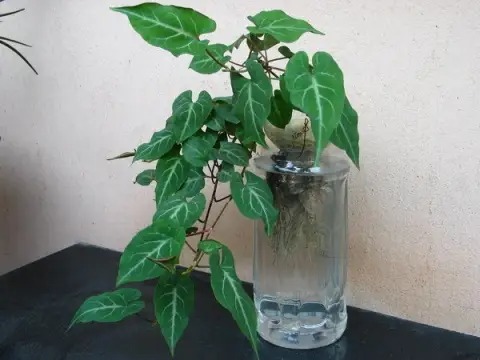
Varieties suitable for hydroponic flowers
: Carnation, asparagus, gerbera, tulip, hyacinth, chrysanthemum, calla lily, gloxinia, cyclamen, rose, gladiolus, orchid, dieffenbachia, Manli Ficus, Brazilian wood, Hulk, Schefflera arborvitae and bonsai flowers (such as Fujian tea and Murraya) have good hydroponic effects.
Other flowers that can be hydroponically cultivated include Monstera, Milan, Clivia, Camellia, Rose, Jasmine, Azalea, Golden Wu, Dieffenbachia, Violet, Phalaenopsis, Fuchsia, Five-needle Pine, Camptotheca acuminata, Rubber Ficus, Brazilian Iron, Begonia, Fern, Palm, etc. There are also various foliage plants. Such as the Araceae family's clustered spring taro, silver-wrapped taro, anthurium, Guangdong spider plant, silver-edged evergreen; the sedum species' lotus palm, hibiscus palm and other species' Clivia, Paphiopedilum, Christmas cactus, lucky bamboo, hanging pineapple, cineraria, Brazilian wood, ivy, coleus and more than 100 other species.
Issues that should be noted during hydroponics
(1) When preparing nutrient solution, avoid using metal containers, let alone using them to store nutrient solution. It is best to use glass, enamel or ceramic containers.
(2) If tap water is used when preparing nutrient solution, it must be treated because most tap water contains chlorides and sulfides, which are harmful to plants. Some bicarbonates can also hinder the root system's absorption of iron. Therefore, when using tap water to prepare nutrient solution, a small amount of sodium ethylenediaminetetraacetic acid or humate compounds should be added to treat chlorides and sulfides in the water. If peat is used as the substrate for hydroponic flower technology, the above disadvantages can be eliminated. If the groundwater quality is poor, you can use unpolluted river or lake water.
(3) In general, the cultivation water in the pot should be replaced every one or two months. Tap water can be used, but be careful to leave the tap water for a period of time before using it to keep the root temperature stable.
(4) Most hydroponic flowers are negative and neutral flowers suitable for indoor cultivation, and they have their own requirements for light. Negative flowers such as ferns, orchids, and Araceae plants should be shaded appropriately; medium-sized flowers such as Monstera, Schefflera, and Poinsettia are not strict about light intensity. They generally like plenty of sunlight and can grow normally under the shade. It is important to ensure the temperature for the normal growth of flowers. The roots of flowers grow well in the range of 15-30 degrees.
(5) You should pay attention to distinguish the root color of flowers to determine whether they are growing well. When the light, temperature, and nutrient solution concentration are appropriate, the whole root or root tip is white. Please note that it is strictly forbidden to use excessive nutrient solution and it is strictly forbidden to shorten the time interval for adding nutrient solution.
(6) During the growth of hydroponic flowers, if water droplets are found oozing from the leaf tips, the water level needs to be lowered appropriately to allow more roots to be exposed to the air and reduce the proportion of immersion in water.
Preparation of nutrient solutions commonly used for hydroponic seedlings Hydroponic seedlings use
water as a medium, which does not contain the nutrients required for plant growth. Therefore, necessary nutrient solutions must be prepared to provide for plant rooting and seedling growth before transplantation. The selection of nutrient solution formulas for different plants is the key to successful hydroponic seedlings. Different plants have different nutrient solution formulas. Here is a widely used nutrient solution formula.
Versailles nutrient solution formula (grams of various compounds in 1 L of water)
Macroelements
Potassium nitrate 0.568
Calcium nitrate 0.710
Ammonium phosphate 0.142
Magnesium sulfate 0.284
Ferric chloride 0.112
Total 1.816
Trace elements
Potassium iodide 0.002 84
Boric acid 0.000 56
Zinc sulfate 0.000 56
Manganese sulfate 0.000 56
Total 0.004 52
(Prepare a certain concentration of concentrate first, and dilute it with water when using)
In my personal opinion, we usually hydroponically grow flowers and plants at home. It is troublesome to prepare them by ourselves. You can buy nutrient solution at the flower shop for 2-3 yuan.
To hydroponically grow flowers, you must understand its habits and requirements.
Technical requirements for hydroponics of flowers
From the perspective of the cycle of plant growth, there are two technical stages in hydroponics of flower technology that need to be paid attention to; one is the seedling cultivation stage, that is, the water propagation process; the other is the care stage of the finished plant, that is, the hydroponics process for personal operation by the user. Through the above two stages of work, following the correct cultivation rules and paying attention to the problems that should be paid attention to during the cultivation process, we can see beautiful, clean, elegant and healthy hydroponic flowers entering thousands of households.
The establishment and method of hydroponic seedling beds
The hydroponic seedling beds must be watertight. They are mostly made of concrete or bricks and covered with film. The width is 1.2-1.5 meters, and the length depends on the scale. It is best to build a stepped seedling bed, which is conducive to the flow of water and increases the oxygen content in the water. The electric heating wire for water heating is laid at the bottom of the bed to keep the water temperature stable at the optimal rooting temperature of 21-25℃. Hydroponic can be carried out all year round. The water temperature is controlled at about 25℃ by the control instrument. Too high or too low is not good for rooting. When hydroponic, the plant seedlings should be shallowly inserted, and the water or nutrient solution should be 5-8 cm in the bed. But in order to keep the plant seedlings stable, clean sand can be put at the bottom. This method can also be called sand water propagation. Or you can drill holes in the styrofoam board, or set up a grid on the water surface, insert the plant seedlings on the board and put them in the water. During the rooting process, use a water pump to pump water regularly every day to keep the water oxygenated.
--------The above is a large-scale hydroponic culture, which can actually be applied to the family. My family just puts it in a large beverage bottle and changes the water every day. After the roots are formed, there is no need to change it every day. In fact, I change it when I think of it, which belongs to free-range cultivation.
How to transform soil-grown flowers into hydroponic flowers
Directly using general soil-grown seedlings and transplanting them into hydroponic pots is a good strategy. The specific methods are as follows:
1. Planting of large seedlings
Remove the pot: Tap the surroundings of the flower pot with your hands, and the whole plant can be removed from the pot after the soil is loosened. Remove the soil, first gently remove the excess soil with your hands (until it can be directly rinsed with water). Washing: Rinse the soil or substrate stuck to the roots with water. Cut the planting basket: If the head of the plant is too large and the aperture of the planting basket is too small, the hole of the planting basket needs to be enlarged for easy planting. Add nutrient solution: add the prepared nutrient solution to the container. Planting of large seedlings: insert the roots of the plants from the planting basket, be careful not to hurt the roots. Fixation: fix with sponge, granite or rain flower stone (other solid objects can also be used).
2. Planting of small seedlings
Planting of small seedlings is much simpler than planting of large seedlings. The main steps are as follows: Pot seedlings: seedlings are generally not more than 8 cm. Washing roots of seedlings: take the seedlings directly out of the pot, wash the roots in water, and be careful not to hurt the roots. Planting of seedlings: insert the roots directly from the holes of the planting basket and fix them with stones.
3. Blending of nutrient solution
Users can purchase and prepare it at a chemical reagent store according to the formula provided in this article. At the same time, you can also use urea and other fertilizers for preparation research according to the local fertilizer source conditions, and use them in production after gaining experience. The preparation principle of other fertilizers is to control the total concentration at 0.1-0.2%.
4. Key points for transplanting flowers The
water level of hydroponic flowers must be controlled well, and it should be low rather than high. The roots can be in water, or even less (maintain an adaptation period of one month, and then increase the amount of water). During the hydroponic process, when water droplets appear on the tips of the leaves of the flowers, the water level needs to be lowered appropriately, and direct sunlight should be avoided at the beginning.
Comment on this photo
 and forward it to Weibo
and forward it to Weibo